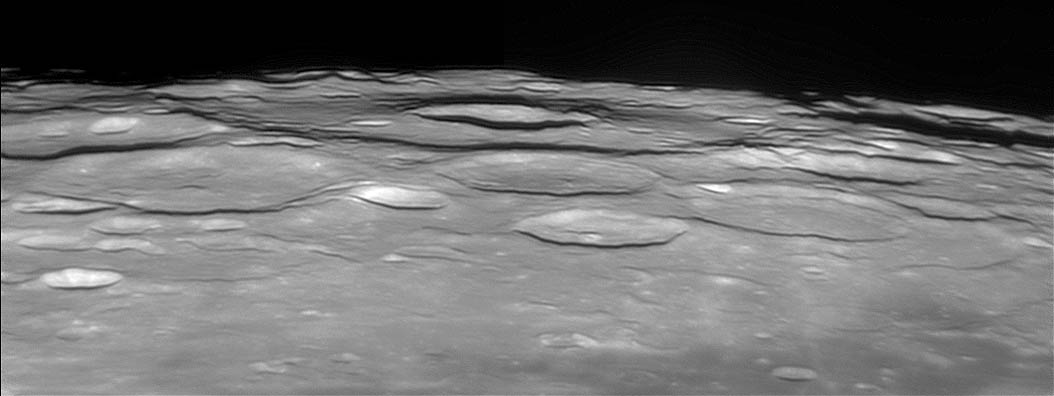Difference between revisions of "May 19, 2005"
| Line 15: | Line 15: | ||
</table> | </table> | ||
<table width="80%" border="0" align="center" cellpadding="8"> | <table width="80%" border="0" align="center" cellpadding="8"> | ||
| − | <tr><td><div align="center" class="main_sm">Image Credit: [mailto:dpeach_78@yahoo.co.uk Damian Peach]</p> | + | <tr><td><div align="center" class="main_sm"><p>Image Credit: [mailto:dpeach_78@yahoo.co.uk Damian Peach]</p> |
</div></td> | </div></td> | ||
</tr> | </tr> | ||
| Line 24: | Line 24: | ||
<p align="left">The eastern limb of the Moon is often imaged, perhaps because it is readily available in the early evening hours. But the western limb - which at sunrise is also visible at a convenient time, is much less commonly imaged, especially the areas north of Orientale. Damian Peachs recent image shows what can be seen on this limb when the lighting, seeing and libration all cooperate. At the center is the rarely seen Einstein crater with Einstein A near its center. The formation of A probably removed Einsteins central peak, for with a diameter of 170 km Einstein is too small to be expected to have an inner ring. The other craters named on the mouseover are also infrequently observed, and Ive never before seen an image of Moseley (I think Ive identified it correctly) at 90.1° West. The high sun Clementine Atlas image (Plate 37) shows a very bright small crater near the NE rim of Einstein (<i>bc</i> on overlay) that doesnt look like much in this unrectified low sun view. But at higher illuminations it must be a searchlight! Einstein and most of the larger craters in this area are smothered in continuous ejecta deposits from Orientale (off the image to the left) and most of the small fresh craters are Orientale secondaries.</p> | <p align="left">The eastern limb of the Moon is often imaged, perhaps because it is readily available in the early evening hours. But the western limb - which at sunrise is also visible at a convenient time, is much less commonly imaged, especially the areas north of Orientale. Damian Peachs recent image shows what can be seen on this limb when the lighting, seeing and libration all cooperate. At the center is the rarely seen Einstein crater with Einstein A near its center. The formation of A probably removed Einsteins central peak, for with a diameter of 170 km Einstein is too small to be expected to have an inner ring. The other craters named on the mouseover are also infrequently observed, and Ive never before seen an image of Moseley (I think Ive identified it correctly) at 90.1° West. The high sun Clementine Atlas image (Plate 37) shows a very bright small crater near the NE rim of Einstein (<i>bc</i> on overlay) that doesnt look like much in this unrectified low sun view. But at higher illuminations it must be a searchlight! Einstein and most of the larger craters in this area are smothered in continuous ejecta deposits from Orientale (off the image to the left) and most of the small fresh craters are Orientale secondaries.</p> | ||
<blockquote> | <blockquote> | ||
| − | <p align="right">— [mailto:tychocrater@yahoo.com Chuck Wood]</blockquote> | + | <p align="right">— [mailto:tychocrater@yahoo.com Chuck Wood]</p></blockquote> |
<p align="left"><b>Technical Details:</b><br> | <p align="left"><b>Technical Details:</b><br> | ||
April 24, 2005. C9.25 from a beautiful southern Caribbean vacation isle! | April 24, 2005. C9.25 from a beautiful southern Caribbean vacation isle! | ||
| Line 32: | Line 32: | ||
[[iv_188_h2.jpg|Lunar Orbiter 4 View]] | [[iv_188_h2.jpg|Lunar Orbiter 4 View]] | ||
<br>Rukl Plate 17 | <br>Rukl Plate 17 | ||
| + | </p> | ||
<p align="left"><b>Tomorrow's LPOD: </b> Two in a Row</p> | <p align="left"><b>Tomorrow's LPOD: </b> Two in a Row</p> | ||
</tr> | </tr> | ||
Revision as of 21:20, 17 January 2015
Rarely Seen Genius
Image Credit: Damian Peach |
|
Rarely Seen Genius The eastern limb of the Moon is often imaged, perhaps because it is readily available in the early evening hours. But the western limb - which at sunrise is also visible at a convenient time, is much less commonly imaged, especially the areas north of Orientale. Damian Peachs recent image shows what can be seen on this limb when the lighting, seeing and libration all cooperate. At the center is the rarely seen Einstein crater with Einstein A near its center. The formation of A probably removed Einsteins central peak, for with a diameter of 170 km Einstein is too small to be expected to have an inner ring. The other craters named on the mouseover are also infrequently observed, and Ive never before seen an image of Moseley (I think Ive identified it correctly) at 90.1° West. The high sun Clementine Atlas image (Plate 37) shows a very bright small crater near the NE rim of Einstein (bc on overlay) that doesnt look like much in this unrectified low sun view. But at higher illuminations it must be a searchlight! Einstein and most of the larger craters in this area are smothered in continuous ejecta deposits from Orientale (off the image to the left) and most of the small fresh craters are Orientale secondaries. Technical Details: Related Links: Tomorrow's LPOD: Two in a Row |
|
Author & Editor: Technical Consultant: Contact Translator: A service of: |
COMMENTS?
Register, and click on the Discussion tab at the top of the page.




